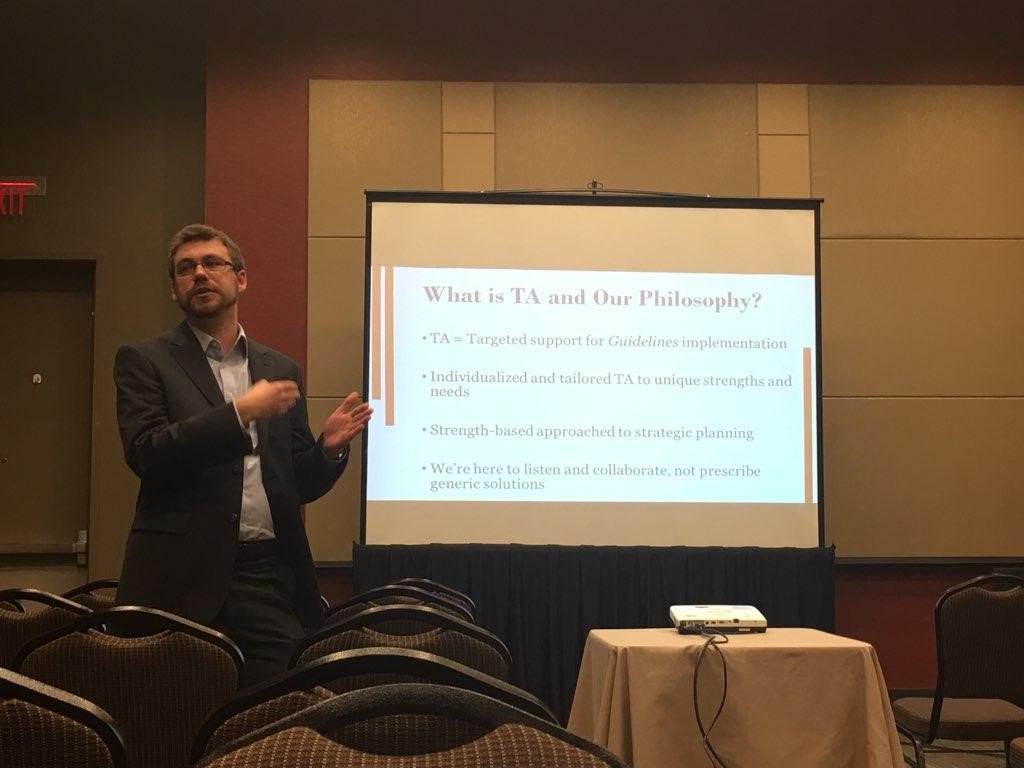Our juvenile drug treatment court team is excited to join our partners and friends at the National Association of Drug Court Professional Annual Conference (NADCP). Don’t miss out on the workshops we are hosting!
The OJJDP Juvenile Drug Treatment Court Guidelines Workshop: Kids Matter
Wednesday, May 30, 8:45 a.m. – 2:30 p.m. | 351 B/E
Trainers: Matthew Collinson, Evan Elkin, Bridgett Ortega, Jessica Pearce, Doris Perdomo-Johnson, Zoë Root, Wendy Schiller, Megan Ward, Jacqueline van Wormer
All juvenile drug treatment courts (JDTCs) want to see the best outcomes for the youth in their programs, but until recently there hasn’t been a clear path to achieve this goal. The Office of Juvenile Justice and Delinquency Prevention’s Juvenile Drug Treatment Court Guidelines provide courts with an outline of evidence-based practices shown to respond to the unique needs of adolescents and improve outcomes for youth. Join the Juvenile Drug Treatment Courts Training and Technical Assistance Initiative, a project partnership of the Justice Programs Office at American University and the National Association of Drug Court Professionals, for an in-depth training on how the Guidelines can shape a JDTC that is functional, developmentally appropriate, equitable, and results in youth living healthy and save lives.
The Juvenile Drug Treatment Court Guidelines: The Big Picture, The Critical Details
Thursday, May 31 at 9:30 a.m. – 10:45 a.m. | 360 AD
Presenters: Zoë Root and Jacqueline van Wormer
All juvenile drug treatment courts want to see the best outcomes for the youth in their programs, but until recently there hasn’t been a clear path to achieve this goal. The Office of Juvenile Justice and Delinquency Prevention’s Juvenile Drug Treatment Court Guidelines provide courts with an outline of evidence-based practices shown to respond to the unique needs of adolescents and improve outcomes for youth. Join the Juvenile Drug Treatment Courts Training and Technical Assistance Initiative, a project partnership of the Justice Programs Office at American University and the National Association of Drug Court Professionals, for an overview of the key principals of the Guidelines.
Evidence-Based Substance Use Disorder Treatment for Juveniles
Thursday, May 31 at 3:15 p.m. – 4:30 p.m. | 360 AD
Presenter: Doris Perdomo-Johnson
It is well established that youth differ significantly from adults in brain development, affecting their behavior and risk-taking calculations. Join Doris Perdomo-Johnson, clinical research coordinator at the University of Miami, to learn how juvenile drug treatment courts (JDCTs) should apply an adolescent-based approach in the development of their policies and procedures and improve outcomes for the youth in their court. Ms. Perdomo-Johnson will explore the differences between adolescent and adult substance use, effective methods to address substance use during the teenage years, and ultimately the creation of a “culture of change, acceptance, and resilience” in JDTCs.
Prescription Opioid Use Among Youth and Implications for Juvenile Drug Treatment Courts with
Friday, June 1 at 1:45 p.m. – 3:00 p.m. | 320 C
Presenter: Marc Fishman, MD
The rate of opioid use among teens may not be as high as in the adult population, but recent research has shown that youth are much more likely to experience negative outcomes from opioid misuse than adults. Dr. Marc Fishman will discuss prevention strategies for opioid misuse and how juvenile drug treatment courts (JDTCs) can play a role in implementing those strategies. In addition, JDTC practitioners will receive training on how this public health concern could potentially affect the participants of their programs and how they should be prepared to respond.
 juvenile drug treatment courts (JDTCs) I work with, seek to bring about behavior change and ensure public safety, without the iatrogenic consequences of incarceration.
juvenile drug treatment courts (JDTCs) I work with, seek to bring about behavior change and ensure public safety, without the iatrogenic consequences of incarceration.
 My role at the Justice Programs Office (JPO) is to be heard but rarely seen. I am not asked to go to conferences and present on the constitutional right to counsel. I am certainly not going out into the field to provide training and technical assistance to
My role at the Justice Programs Office (JPO) is to be heard but rarely seen. I am not asked to go to conferences and present on the constitutional right to counsel. I am certainly not going out into the field to provide training and technical assistance to  Evening news stories’ headlines, bloggers, public opinion, all broadcast the dangerous effects of social media on today’s youth. Some argue that online sharing has replaced human interaction, stunting emotional growth and leaving young people socially isolated. Others fret that the increased access to sexual and violent content and general vulgarity that the internet allows is causing an erosion of teens’ moral perceptions. Whatever the conclusion, it seems everyone agrees the kids are not alright.
Evening news stories’ headlines, bloggers, public opinion, all broadcast the dangerous effects of social media on today’s youth. Some argue that online sharing has replaced human interaction, stunting emotional growth and leaving young people socially isolated. Others fret that the increased access to sexual and violent content and general vulgarity that the internet allows is causing an erosion of teens’ moral perceptions. Whatever the conclusion, it seems everyone agrees the kids are not alright.


